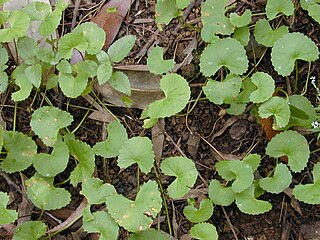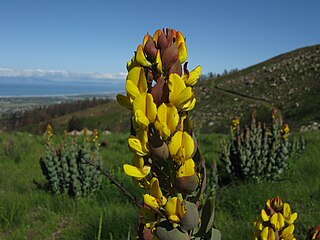
Cynoglossum is a genus of small-flowered plants in the family Boraginaceae. It includes 81 species native to Eurasia, Africa, New Guinea, and Australia.

Centella is a genus of 53 species of flowering plants in the subfamily Mackinlayoideae. The genus is sometimes placed in family Araliaceae; however, recent studies utilising molecular data place Centella within Apiaceae.

Alepidea is a genus of about 30 species in the family Apiaceae, all of which are endemic to Africa. They occur mainly in southern Africa, but can be found as far north as Ethiopia.

Lotononis is a genus of flowering plants in the family Fabaceae and the tribe Crotalarieae. The genus includes 99 species of annual and perennial herbs, native to the southeastern Europe and Turkey, eastern Africa, and southern Africa.

Lessertia is a genus of flowering plants in the legume family, Fabaceae. It contains some 62 species native to eastern and southern Africa. It belongs to subfamily Faboideae.

Rafnia is a genus of flowering plants in the family Fabaceae. It includes 29 species of shrubs and subshrubs native to South Africa. They grow in Mediterranean-climate fynbos (shrubland) and grassland, mostly on rocky and sandy soils. Most are native to the Cape Provinces, with some extending eastwards into KwaZulu-Natal. It belongs to subfamily Faboideae.

Ifloga is a genus of flowering plants in the family Asteraceae.

Vellereophyton is a genus of flowering plants in the family Asteraceae.
Dasispermum are a genus of flowering plants in the family Apiaceae, native to coastal area of southern South Africa. Short-lived perennial or annuals, they are low-lying, often sprawling herbs with succulent or semi-succulent leaves, adapted to the dry, salty conditions of the littoral areas where they grow.

Causonis is a genus of flowering plants belonging to the family Vitaceae; it is now placed in the tribe Cayratieae.
Polemanniopsis is a genus of flowering plants belonging to the family Apiaceae.









